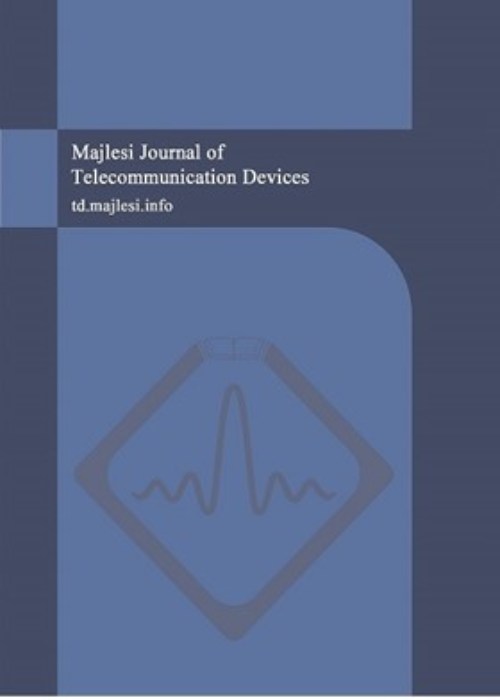فهرست مطالب
Majlesi Journal of Telecommunication Devices
Volume:1 Issue: 4, Dec 2012
- تاریخ انتشار: 1391/11/09
- تعداد عناوین: 7
-
Pages 109-112In this paper, new structures of two-dimensional periodic photonic crystals in the form of dielectric rods with different geometric shapes, are presented. All photonic crystals presented in this paper are in a square lattice. Band structure and photonic band gap limitation graph of these structures are obtained by using numerical methods of plane wave expansion (PWE) for TE and TM modes. The simulation results for these structures show different photonic band gap widths and places for different structures and modes.
-
Pages 113-120In this paper, the design of uniform elliptical array (UEA) with optimum side lobe level reduction is presented. Multi-lobe pattern and adaptive nulling of the pattern is achieved by the control of the antenna elements phases in different states. This method is based on genetic algorithm (GA). The method of genetic algorithm is used to determine an optimum set of array factor cost that provide a radiation pattern with maximum side lobe level reduction with constraint of a suitable main lobe beamwidth. The results show that synthesis of the uniform elliptical antenna array by using GA method provide a side lobe level reduction and main lobe beamwidth better than circular antenna array obtained by using IWO (Invasive Weeds Optimization) and also optimized elliptical antenna array by using EPL (The Excitations Of Elements Phases at Eccentricity Low Level).
-
Pages 121-124Monitoring the processing of gas transmitters, pressure, flow and temperature as SCADA systems, and now with the cost of communication is done Industrial Automation and Instrumentation design a monitoring system is proposed Industrial Automation and Instrumentation design a monitoring system is proposed. Gas dispatching system based on wireless sensor networks, SCADA systems, unlike the systems that have been used in gas dispatching centers,Configuration and reduce network deployment costs on the one hand and on the other hand, instead of installing thousands of feet of wire just Which are small devices about the size of a dime and put points on the network simply by adding more nodes expanded. The data collected and transferred to control room temperature and pressure measurements by monitoring input and output can be controlled more. In this article we describe an intelligent system for monitoring wireless sensor network is useful for applications in oil, gas company.
-
Pages 125-126Low-noise amplifiers (LNA) are considered one of the essential components of telecommunication wireless receiver. Since their performance will determine the system performance in the noise. In this paper with software Microwave office, a low-noise amplifier has been designed and simulated at the center frequency of 8 GHz with 10 dB of gain and noise figure less than 1.5dB in operating point 2 V and 10mA.
-
Pages 127-131In this essay, we propose a Multiband Spectrum Sensing (MSS) approach that utilizes randomized sampling and its spectral analysis to accomplish the sensing task using considerably low sampling rates. Since the spectrum sensing procedure does not necessitate signal reconstructing, it is shown that the sampling rates can be arbitrarily low for some randomized sampling schemes. Most importantly, general guidelines are provided to ensure that the developed MSS satisfies certain detection probabilities set by the user. Spectrum sensing involves scanning predefined part(s) of the radio spectrum in search of meaningful activity such as an ongoing transmission or the occurrence of an event. Standard communications laboratory test equipment, e.g. spectrum analyzers, can perform similar functionality. They conventionally sweep the spectrum using a narrowband tunable bandpass filter(s) and determine the energy within each of the scanned spectral bands.
-
Pages 132-137Radar Cross Section (RCS) reduction is very important factor to increase survivability. This paper used a model of the Unmanned Aerial Vehicle (UAV) will be as a reference and focus on RCS reduction by using shaping methods. Simulation software CST was used to calculate the RCS of aerial targets. Four types of target geometries are simulated to find the final optimal design which will give a less value of RCS compared with the reference geometry over X-Band (8, 9,10,11,12 GHz are used for simulation then average value is drowned).
-
Pages 138-144UWB communication system is a new high performance technique with low power consumption which has a large application for very high data rates in wireless telecommunications. In this paper, the image transfer techniques using MIMO-UWB wireless environment is introduced in MDC deals. This idea is new and so far that there is no record of it. First, direct sequence ultra wide band performance techniques are analyzed for channels fading. Image transmission is then implemented with multiple description coding and with no multiple descriptions coding of image. The method of multiple description coding ensures that the version that the loss does not need to retransmit the missing version and acceptable quality of image obtain against the channel errors. Send a picture of the proposed system with different number of transmitter and receiver antennas have been numerous experiments confirm the success of the method. Experimental results show that the desired goals are reached.


